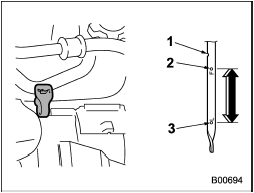Checking the oil level
Check the engine oil level at each fuel stop.
1. Park the vehicle on a level surface and stop the engine.

2. Pull out the level gauge that has the У Ф symbol on top, wipe it clean, and insert it again.
Ф symbol on top, wipe it clean, and insert it again.
3. Be sure the level gauge is correctly inserted until it stops.

1) Notch
2) Upper level
3) Lower level
4. Pull out the level gauge again and check the oil level on it. If it is below the lower level, add oil to bring the level up to the upper level.

Х Use only engine oil with the recommended grade and viscosity.
Х Be careful not to spill engine oil when adding it. If oil touches the exhaust pipe, it may cause a bad smell, smoke, and/or a fire. If engine oil gets on the exhaust pipe, be sure to wipe it off.
Х If the level gauge is not pulled out easily, twist the level gauge right and left, then pull it out. Otherwise, you may be injured accidentally straining yourself.
If you check the oil level just after stopping the engine, wait a few minutes for the oil to drain back into the oil pan before checking the level.
Just after driving or while the engine is warm, the engine oil level reading may be in a range between the upper level and the notch mark. This is caused by thermal expansion of the engine oil.
To prevent overfilling the engine oil, do not add any additional oil above the upper level when the engine is cold.
See also:
Viewing range on the screen
Range of view
Range of view
Image from camera
The area from the rear end of the bumper
can be viewed. Areas at both ends of the
bumper and areas just under the bumper
cannot be vi ...
Keys
1) Master key
2) Submaster key
3) Valet key
4) Key number plate
5) Security ID plate
Three types of keys are provided for your vehicle:
Master key, submaster key and valet key. The master key ...
Calculating total and load capacities varying seating configurations
Calculate the available load capacity as shown in the following examples:
Example 1A
Vehicle capacity weight of the vehicle is 800 lbs (363 kg), which is indicated
on the vehicle placard with th ...


